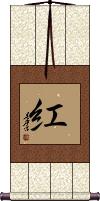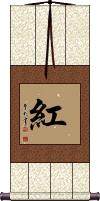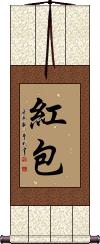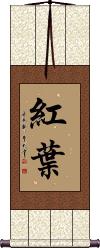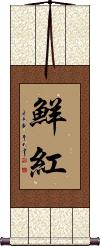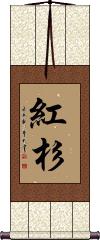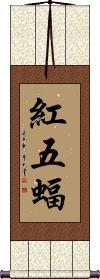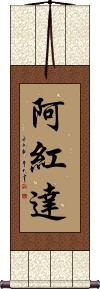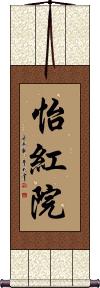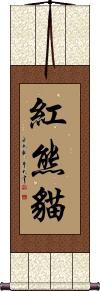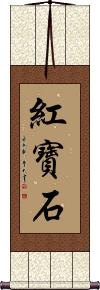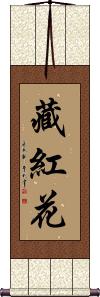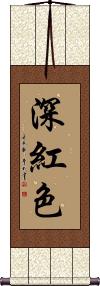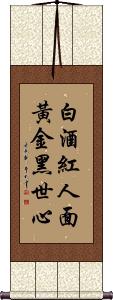Many custom options...
And formats...

紅 in Chinese / Japanese...
Buy an 紅 calligraphy wall scroll here!
Personalize your custom “紅” project by clicking the button next to your favorite “紅” title below...
1. Beni
2. Red Color
3. Red Envelope
6. Sequoia
8. Alhondra
11. Ruby
12. Saffron
15. Just as Liquor Turns a Face Red, Gold Turns a Heart Black
Beni
Red Color
紅 is a single character that means red in Chinese, Japanese Kanji, and old Korean Hanja.
The perceived meaning of this character can be ambiguous. Most will see it as the color red but it can also mean Communist (just like it can in English). In Japanese, it can be a female given name “Rena,” or refer to red silk lining. In Chinese, red is a good luck color, and can refer to a bonus or revolutionary.
Red Envelope
紅包 literally means “red treasure.”
Depending on the context, it can also mean “money wrapped in red as a gift,” “a bonus payment,” “a kickback,” or “a bribe.”
However, most of the time, this is an innocent gift of money in a red envelope that is given from an elder relative to a youngster. This usually happens during the Chinese New Year. It can also happen in preparation for or during a wedding in China.
紅包 is pronounced “Hong Bao” (with an “oh” vowel sound on hong) in Mandarin Chinese. Filipino Chinese call it “Ang Pao.” There are a few other variations.
Red Leaves of Autumn
Scarlet / Bright Red
Sequoia
Five Red Bats
紅五蝠 is a play on words in Chinese because of some homophones.
The first thing you need to know is that the word for bat, 蝠, sounds exactly like the word for good fortune, 福. Thus, bats are often associated with good luck and good fortune in Chinese culture.
Five bats (五福 / 五蝠) means “five fortunes,” referring to luck, prosperity, wealth, happiness, and longevity.
The word red, 红, has the same sound as 宏 meaning vast, great, or magnificent. Therefore, a red bat means “vast fortune.”
Altogether, five red bats represent vast reaches of the five fortunes.
Alhondra
House of Red Delights
怡紅院 is from “The Story of the Stone” by Cao Xueqin.
For some reason, this phrase was translated as “House of Green Delights” when the novel was published in English. The translator took some liberties and believed that “green” had a more positive feel than red to a western audience. Therefore, the phrase shown to the right is “House of Red Delights” (which is the most original and correct way).
Red Panda / Firefox
Ruby
Saffron
Scarlet / Crimson
The Red Thread of Fate
姻緣紅線 is the legendary red string of destiny that binds all soul mates or lovers together.
In ancient Chinese culture, a mythological matchmaker named 月老 (Yuè Lǎo) was the controller of the fate that led lovers to meet. He did this by tying a celestial red string to the ankle of each person. Sometime during their life, they will meet and marry as fate dictates.
While the origin of the red string comes from China, it has spread to other parts of Asia (such as Japan, where it's known as 赤い糸).
Just as Liquor Turns a Face Red, Gold Turns a Heart Black
白酒紅人面黃金黑世心 literally says: [Just as] white liquor makes people's faces turn red, [So] yellow gold makes people's hearts turn black.
This is a warning about the nature of greed. The suggestion is that one who lusts for gold and riches will eventually have a black heart (or become a heartless greedy bastard). As a wall scroll, this is a reminder and warning to keep yourself from following the greedy path.
Mountain Travels Poem by Dumu
This poem was written almost 1200 years ago during the Tang dynasty.
It depicts traveling up a place known as Cold Mountain, where some hearty people have built their homes. The traveler is overwhelmed by the beauty of the turning leaves of the maple forest that surrounds him just as night overtakes the day, and darkness prevails. His heart implores him to stop, and take in all of the beauty around him.
First, before you get to the full translation, I must tell you that Chinese poetry is a lot different than what we have in the west. Chinese words simply don't rhyme in the same way that English or other western languages do. Chinese poetry depends on rhythm and a certain beat of repeated numbers of characters.
I have done my best to translate this poem keeping a certain feel of the original poet. But some of the original beauty of the poem in its original Chinese will be lost in translation.
Far away on Cold Mountain, a stone path leads upwards.
Among white clouds, people's homes reside.
Stopping my carriage I must, as to admire the maple forest at nights fall.
In awe of autumn leaves showing more red than even flowers of early spring.
Hopefully, this poem will remind you to stop, and “take it all in” as you travel through life.
The poet's name is “Du Mu” in Chinese that is: ![]()
![]() .
.
The title of the poem, “Mountain Travels” is: ![]()
![]()
You can have the title, poet's name, and even “Tang Dynasty” written as an inscription on your custom wall scroll if you like.
More about the poet:
Dumu lived from 803-852 AD and was a leading Chinese poet during the later part of the Tang dynasty.
He was born in Chang'an, a city in central China and the former capital of the ancient Chinese empire in 221-206 BC. In present-day China, his birthplace is currently known as Xi'an, the home of the Terracotta Soldiers.
He was awarded his Jinshi degree (an exam administered by the emperor's court which leads to becoming an official of the court) at the age of 25 and went on to hold many official positions over the years. However, he never achieved a high rank, apparently because of some disputes between various factions, and his family's criticism of the government. His last post in the court was his appointment to the office of Secretariat Drafter.
During his life, he wrote scores of narrative poems, as well as a commentary on the Art of War and many letters of advice to high officials.
His poems were often very realistic and often depicted everyday life. He wrote poems about everything, from drinking beer in a tavern to weepy poems about lost love.
The thing that strikes you most is the fact even after 1200 years, not much has changed about the beauty of nature, toils, and troubles of love and beer drinking.
Not the results for 紅 that you were looking for?
Below are some entries from our dictionary that may match your 紅 search...
| Characters If shown, 2nd row is Simp. Chinese |
Pronunciation Romanization |
Simple Dictionary Definition |
紅 红 see styles |
hóng hong2 hung rena れな |
More info & calligraphy: Red Color(1) deep red; crimson; (2) (べに only) rouge; lipstick; (female given name) Rena aruṇa, rakta; red. |
紅包 红包 see styles |
hóng bāo hong2 bao1 hung pao honbao; honpao ホンバオ; ホンパオ |
More info & calligraphy: Red Envelopered envelope (New Year's gift in Sinic cultures) (chi: hóngbāo) |
紅葉 红叶 see styles |
hóng yè hong2 ye4 hung yeh moyo もよ |
More info & calligraphy: Red Leaves of Autumn(n,vs,vi) (See 黄葉) leaves turning red (in autumn); red leaves; autumn colours; fall colors; (female given name) Moyo |
鮮紅 鲜红 see styles |
xiān hóng xian1 hong2 hsien hung senkou / senko せんこう |
More info & calligraphy: Scarlet / Bright Redscarlet; bright red; (given name) Senkou |
深紅色 深红色 see styles |
shēn hóng sè shen1 hong2 se4 shen hung se shinkoushoku / shinkoshoku しんこうしょく |
More info & calligraphy: Scarlet / Crimsonscarlet; deep crimson |
紅寶石 红宝石 see styles |
hóng bǎo shí hong2 bao3 shi2 hung pao shih |
More info & calligraphy: Ruby |
紅熊貓 红熊猫 see styles |
hóng xióng māo hong2 xiong2 mao1 hung hsiung mao |
More info & calligraphy: Red Panda / Firefox |
藏紅花 藏红花 see styles |
zàng hóng huā zang4 hong2 hua1 tsang hung hua |
More info & calligraphy: Saffron |
万紅 see styles |
maku まく |
(female given name) Maku |
三紅 see styles |
miku みく |
(female given name) Miku |
中紅 see styles |
nakakurenai なかくれない |
medium crimson |
丸紅 see styles |
marubeni まるべに |
(1) (organization) Marubeni Corporation; (2) (surname) Marubeni; (o) Marubeni Corporation; (surname) Marubeni |
丹紅 see styles |
tankou / tanko たんこう |
red; deep red; crimson |
久紅 see styles |
hisako ひさこ |
(female given name) Hisako |
五紅 see styles |
gokou / goko ごこう |
(given name) Gokou |
亜紅 see styles |
ako あこ |
(female given name) Ako |
亞紅 see styles |
ako あこ |
(female given name) Ako |
佐紅 see styles |
sasao ささお |
(personal name) Sasao |
冬紅 see styles |
toukou / toko とうこう |
(given name) Toukou |
凛紅 see styles |
rinku りんく |
(female given name) Rinku |
分紅 分红 see styles |
fēn hóng fen1 hong2 fen hung |
dividend; to award a bonus |
加紅 see styles |
kagami かがみ |
(personal name) Kagami |
千紅 see styles |
chibeni ちべに |
(female given name) Chibeni |
南紅 see styles |
nankou / nanko なんこう |
(given name) Nankou |
口紅 口红 see styles |
kǒu hóng kou3 hong2 k`ou hung kou hung kuchibeni くちべに |
lipstick (noun - becomes adjective with の) lipstick |
吏紅 see styles |
riku りく |
(female given name) Riku |
吟紅 see styles |
ginkou / ginko ぎんこう |
(given name) Ginkou |
和紅 see styles |
kazue かずえ |
(female given name) Kazue |
咲紅 see styles |
saku さく |
(female given name) Saku |
品紅 品红 see styles |
pǐn hóng pin3 hong2 p`in hung pin hung |
magenta; fuschia |
Click here for more 紅 results from our dictionary
The following table may be helpful for those studying Chinese or Japanese...
| Title | Characters | Romaji (Romanized Japanese) | Various forms of Romanized Chinese | |
| Beni | 紅 | benii / beni | ||
| Red Color | 紅 红 | beni | hóng / hong2 / hong | hung |
| Red Envelope | 紅包 红包 | hóng bāo / hong2 bao1 / hong bao / hongbao | hung pao / hungpao | |
| Red Leaves of Autumn | 紅葉 红叶 | moyo | hóng yè / hong2 ye4 / hong ye / hongye | hung yeh / hungyeh |
| Scarlet Bright Red | 鮮紅 鲜红 | sen kou / senkou / sen ko | xiān hóng xian1 hong2 xian hong xianhong | hsien hung hsienhung |
| Sequoia | 紅杉 红杉 | hóng shān hong2 shan1 hong shan hongshan | hung shan hungshan |
|
| Five Red Bats | 紅五蝠 红五蝠 | hóng wǔ fú hong2 wu3 fu2 hong wu fu hongwufu | hung wu fu hungwufu |
|
| Alhondra | 阿紅達 阿红达 | ā hóng dá a1 hong2 da2 a hong da ahongda | a hung ta ahungta |
|
| House of Red Delights | 怡紅院 怡红院 | yí hóng yuàn yi2 hong2 yuan4 yi hong yuan yihongyuan | i hung yüan ihungyüan |
|
| Red Panda Firefox | 紅熊貓 红熊猫 | hóng xióng māo hong2 xiong2 mao1 hong xiong mao hongxiongmao | hung hsiung mao hunghsiungmao |
|
| Ruby | 紅寶石 红宝石 | hóng bǎo shí hong2 bao3 shi2 hong bao shi hongbaoshi | hung pao shih hungpaoshih |
|
| Saffron | 藏紅花 藏红花 | zàng hóng huā zang4 hong2 hua1 zang hong hua zanghonghua | tsang hung hua tsanghunghua |
|
| Scarlet Crimson | 深紅色 深红色 | shin kou shoku shinkoushoku shin ko shoku | shēn hóng sè shen1 hong2 se4 shen hong se shenhongse | shen hung se shenhungse |
| The Red Thread of Fate | 姻緣紅線 姻缘红线 | yīn yuán hóng xiàn yin1 yuan2 hong2 xian4 yin yuan hong xian yinyuanhongxian | yin yüan hung hsien yinyüanhunghsien |
|
| Just as Liquor Turns a Face Red, Gold Turns a Heart Black | 白酒紅人面黃金黑世心 白酒红人面黄金黑世心 | bái jiǔ hóng rén miàn huáng jīn hēi shì xīn bai2 jiu3 hong2 ren2 mian4 huang2 jin1 hei1 shi4 xin1 bai jiu hong ren mian huang jin hei shi xin | pai chiu hung jen mien huang chin hei shih hsin | |
| Mountain Travels Poem by Dumu | 遠上寒山石徑斜白雲生處有人家停車坐愛楓林晚霜葉紅於二月花 远上寒山石径斜白云生处有人家停车坐爱枫林晚霜叶红于二月花 | yuǎn shàng hán shān shí jìng xiá bái yún shēng chù yǒu rén jiā tíng chē zuò ài fēng lín wǎn shuàng yè hóng yú èr yuè huā yuan3 shang4 han2 shan1 shi2 jing4 xia2 bai2 yun2 sheng1 chu4 you3 ren2 jia1 ting2 che1 zuo4 ai4 feng1 lin2 wan3 shuang4 ye4 hong2 yu2 er4 yue4 hua1 yuan shang han shan shi jing xia bai yun sheng chu you ren jia ting che zuo ai feng lin wan shuang ye hong yu er yue hua | yüan shang han shan shih ching hsia pai yün sheng ch`u yu jen chia t`ing ch`e tso ai feng lin wan shuang yeh hung yü erh yüeh hua yüan shang han shan shih ching hsia pai yün sheng chu yu jen chia ting che tso ai feng lin wan shuang yeh hung yü erh yüeh hua |
|
| In some entries above you will see that characters have different versions above and below a line. In these cases, the characters above the line are Traditional Chinese, while the ones below are Simplified Chinese. | ||||
Successful Chinese Character and Japanese Kanji calligraphy searches within the last few hours...
